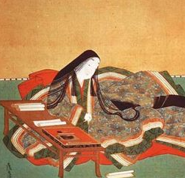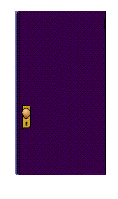Writing and Literature During the Heian Period

Writing was the most valued form of expression in Heian Japan. Everyone was expected to show skill in using words well. Early Heian writers composed artful poems in Chinese. As time went on, distinctly Japanese ways of writing developed, both in daily life and in the creation of works of literature.
Writing in Daily Life Poetry was part of daily life in Heian-kyo. People were expected to make up poetry in public. If they could not think up a few clever lines to fit an occasion, others noticed the failure. Men and women carefully created poems to charm each other. When someone received a poem from a friend, family member, or acquaintance, he or she was expected to write a response. The reply poem was supposed to have the same style, mood, and imagery as the original.
Women Become Japan’s Leading Writers The female companions to the courtiers of Heian-kyo were usually selected for their intelligence. They often took a great interest in literature. As a result, women led the flowering of a golden age of Japanese literature in the 10th and 11th centuries.
The best-known Heian writer was Murasaki Shikibu. Born into the Fujiwara family, she served as a lady-in-waiting to one of the daughters of Michinaga Fujiwara. Her novel, The Tale of Genji, is a Heian masterpiece. Today it is regarded as one of the great works in world literature.
The Tale of Genji is often called the world’s first novel. The book follows the love life of Genji, a fictional prince. It paints a vivid picture of life in the Heian court. Much of the book focuses on the thoughts and feelings of the characters, particularly the women. As a result, The Tale of Genji has served as a model for the modern romance novel.
The other leading writer of the time was Sei Shonagon. Like The Tale of Genji, Shonagon’s Pillow Book presents a detailed picture of life in Heian-kyo. Pillow Book is a collection of clever stories, character sketches, conversations, descriptions of art and nature, and various lists. Here is Shonagon’s list of “Things That Should Be Short”:
A piece of thread when one wants to sew something in a hurry. A lamp stand. The hair of a woman of the lower classes should be neat and short. The speech of a young girl.
Writing in Daily Life Poetry was part of daily life in Heian-kyo. People were expected to make up poetry in public. If they could not think up a few clever lines to fit an occasion, others noticed the failure. Men and women carefully created poems to charm each other. When someone received a poem from a friend, family member, or acquaintance, he or she was expected to write a response. The reply poem was supposed to have the same style, mood, and imagery as the original.
Women Become Japan’s Leading Writers The female companions to the courtiers of Heian-kyo were usually selected for their intelligence. They often took a great interest in literature. As a result, women led the flowering of a golden age of Japanese literature in the 10th and 11th centuries.
The best-known Heian writer was Murasaki Shikibu. Born into the Fujiwara family, she served as a lady-in-waiting to one of the daughters of Michinaga Fujiwara. Her novel, The Tale of Genji, is a Heian masterpiece. Today it is regarded as one of the great works in world literature.
The Tale of Genji is often called the world’s first novel. The book follows the love life of Genji, a fictional prince. It paints a vivid picture of life in the Heian court. Much of the book focuses on the thoughts and feelings of the characters, particularly the women. As a result, The Tale of Genji has served as a model for the modern romance novel.
The other leading writer of the time was Sei Shonagon. Like The Tale of Genji, Shonagon’s Pillow Book presents a detailed picture of life in Heian-kyo. Pillow Book is a collection of clever stories, character sketches, conversations, descriptions of art and nature, and various lists. Here is Shonagon’s list of “Things That Should Be Short”:
A piece of thread when one wants to sew something in a hurry. A lamp stand. The hair of a woman of the lower classes should be neat and short. The speech of a young girl.
Room 6 Questions
1. Why did women become such famous authors during this time?
2. Identify the two books from this section, who wrote each of these books, and briefly describe what is in each.
3. Quickly sketch and label a drawing to illustrate an important idea about writing and literature during the Heian period. For example, you might draw a woman with a brush.
2. Identify the two books from this section, who wrote each of these books, and briefly describe what is in each.
3. Quickly sketch and label a drawing to illustrate an important idea about writing and literature during the Heian period. For example, you might draw a woman with a brush.

